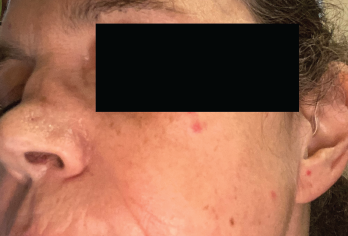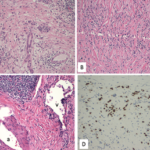
Figure 1. Destruction of the patient’s nasal septum was evident.
Immunoglobulin G4-related disease (IgG4-related disease) is relatively rare, although with greater recognition it is becoming more frequently diagnosed. Some of the more common presentations of the disease include aortitis, cholangitis, autoimmune pancreatitis, sclerosing sialadenitis, orbital disease with proptosis and subacute mass development in the affected organ.1 It has protean manifestations and is diagnosed by classic pathologic findings, which include storiform fibrosis, lymphoplasmacytic infiltrates, eosinophils and obliterative phlebitis.2
This case demonstrates a rare presentation of IgG4-related disease, presenting with a distinct clinical feature of saddle nose deformity. Saddle nose deformity is recognized in other conditions, such as relapsing polychondritis, granulomatosis with polyangiitis, congenital syphilis, leprosy, cocaine use and trauma.3 It is important to consider IgG4-related disease as as one of the potential causes of a saddle nose deformity.
The Case
A 55-year-old white woman presented to her rheumatologist with six months of painless swelling in the submandibular and parotid glands associated with arthralgias, myalgias and weight loss. She never had a fever. Her medical history was significant for gallstones and pancreatitis. At the time, her pancreatitis was thought to have been caused by a viral infection.
Upon evaluation, she had a computerized tomography scan performed that showed destruction of the nasal septum (see Figure 1, right). An endoscopic evaluation revealed nasal septal collapse and erosions. A biopsy revealed lymphoplasmacytic infiltrates, storiform fibrosis, obliterative venulitis and eosinophils. Her serum IgG4 level was 300 mg/dL. Immunohistochemistry showed IgG4 positive plasma cells, more than 60 per high power field.
No evidence of cocaine use, abscess, granulomatosis with polyangiitis, granulomas or giant cells was present. The patient was tested and screened negative for tuberculosis, fungi and syphilis. She had no other organ involvement.
The patient responded well to 1 mg/kg of prednisone and remains stable after plastic surgery.
It is important to consider IgG4-related disease as part of the differential diagnosis of the many causes of a saddle nose deformity.
Discussion
Saddle nose deformity in IgG4-related disease has typically been associated with an increased serum level of IgG4 and classic pathology, such as lymphoplasmacytic infiltrate, storiform fibrosis and obliterative phlebitis. Elevated IgG4 in the serum is not requisite for diagnosis. The number of IgG4-positive plasma cells and ratio of IgG4 to IgG-positive cells varies depending on the tissue involved.4
Although diagnosis may take years of multi-organ manifestations and biopsies of various organ systems, this seemingly rare, but likely underdiagnosed, disease responds very well to glucocorticoids and rituximab. Increased awareness is necessary to start treatment earlier and achieve better outcomes.


